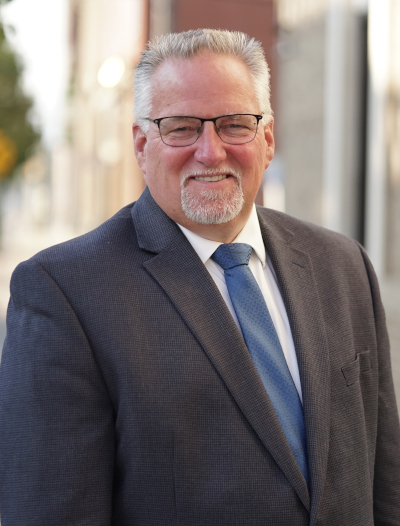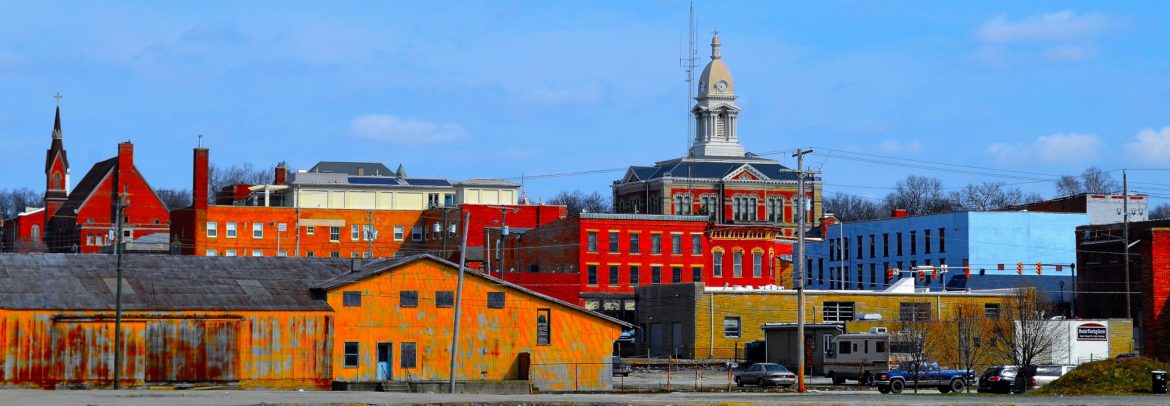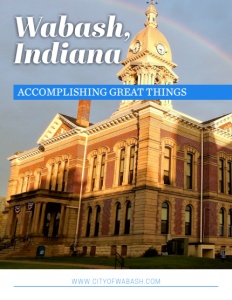Wabash, Indiana
Accomplishing great things
Business View Magazine interviews Scott Long, Mayor of Wabash, Indiana, as part of our focus on best practices of American municipalities.
Wabash is a city in Noble Township, Wabash County, Indiana. The name Wabash derives from a Miami-Illinois Native American term for “water over white stones.” The town was originally platted in 1834 by Col. Hugh Hanna and Col. David Burr on the north bank of the Wabash River, about ninety miles northeast of Indianapolis. Wabash is notable as claiming to be the first electrically lighted city in the world, because on March 31, 1880, at 8PM, four electrified lamps lit up the County Court House before a crowd of awed onlookers amassed from its population of 3,800. One witness, present that evening, wrote the following: “The strange, weird light, exceeded in power only by the sun yet mild as moonlight, rendered the Court House square as light as midday.”

Scott Long, Mayor
Today the population of Wabash is approximately 10,200 and its old electric lights are being replaced by LEDs, according to Mayor Scott A. Long. “Since taking office, one of my first goals was to look down the path of energy savings,” he recounts. “I grew up the child of a manager of a rural electric cooperative, so I was taught at an early age to turn the lights out if you’re not in a room. And technology has changed in such a way that we now have energy-saving capabilities that we didn’t have in the past. So, we retrofitted all of our city buildings with LED lighting to reduce energy consumption; and we took that program to our street lighting. We have decorative street lights, downtown; we swapped those bulbs out to LED. And with any future street light installations, we’ll make sure that the power company installs LED lighting throughout the city wherever we can. Now, that’s going to be a long, arduous process, because you don’t often change your streetlights out. But, those were some of my initial goals and we’ve made great strides in doing that.”
Long, who was born in Wabash, returned to the city after seven years in the military. In 1994, he was hired by the local police department and spent the next 21 years as a police officer, as well as 16 years on the City Council. “So I had a little bit of knowledge about the city prior to being elected mayor,” he says. “I think it gave me a leg up on knowing the whole city, including the areas that most people don’t know about; neighborhoods that I saw as a police officer directly correlate to this job as a mayor and it gave me a little bit of insight when taking office. How can I fix the broken sidewalks? How can I deal with dilapidated properties and find ways to assist the homeowner in maintaining their property rather than go in with an order of demolition because it’s become an unsafe structure? So, that was also one of my goals. And it will save the taxpayers’ money in the long run because typically we’ll pay for an unsafe structure to be demolished, then we put a lien on the property through property taxes, and you may or may not recover that money.”
One of the reasons that residential properties have become run down in Wabash can be attributed to its overall economic situation. “We’ve been in a population decline for a number of years,” Long reports. “Back in 2008, we had a General Tire factory close, here in town. And that was, roughly, 850 jobs that disappeared almost overnight. Obviously, we didn’t have companies with 850 jobs to employ these people. Some of them found jobs, others decided to move elsewhere. So, a lot of the things that I do, right now, are things that I, and the people I work with, think will counter that and encourage people to move to our community. We work hard every day, thinking about our long-term plans: what do we need to do to draw these people in?”
One initiative to achieve that goal has been Wabash’s designation as an Indiana Stellar Community since 2014. The Stellar Communities program is a multi-agency partnership designed to fund comprehensive community development projects in Indiana’s smaller communities. Participants include: the Indiana Housing and Community Development Authority, the Indiana Office of Community and Rural Affairs, and the Indiana Department of Transportation.
“As a part of the program, the city put up $1.3 million in a fund that was derived from Tax Increment Finance revenue that we had received,” says Long. “That resulted in over $32 million investment in downtown buildings. And, along with that, a lot of these retail buildings have built out their second and third floors for apartments. In one of the projects, we took four side-by-side storefronts, downtown, that, years ago, had apartments above them that had become dilapidated. The project received $8.1 million in tax credit funding to retrofit this building with 41 apartment units, along with one restaurant that remains downstairs. And 80 percent of the units are for 55 and older folks who don’t want to maintain a home any longer. They can live downtown in a nice apartment and walk to a lot of amenities, downtown.”
A corresponding initiative was the city’s 2014-2018 Strategic Investment Plan (SIP), a four-year strategic plan defining a vision, a set of goals, and projects selected with input from many community members and leaders. The loft apartment project was part of the SIP, as was a program to help rehabilitate owner-occupied housing. Other projects in the SIP include: renovations to the Eagles Theatre, a 440-seat edifice built in 1906; creating an all inclusive playground at the John Drook Memorial Park; making improvements to the State Road 13/15 corridor; creating an outdoor amphitheater at Paradise Spring; making various streetscape and connectivity improvements; establishing a combined Trails project; and continuing a façade improvement program for downtown buildings.

Long adds that the city is also currently investing in cleaning up dilapidated buildings that are considered brownfields, working with the Indiana Department of Environmental Management and the Indiana Finance Authority through the Brownfields Remediation program. “We are also tackling neighborhood blight, not only to demolish unsafe buildings in residential areas, but to ensure that replacement homes that are built on empty lots conform to the surrounding neighborhood,” he notes. “We want the character of our neighborhoods to remain intact and not build a modern home in a craftsman style neighborhood.”
Going back to the city’s overall economic picture, the good news in Wabash is that there are some thriving legacy businesses that have been in town for years. “Our longest tenured factory is Ford Meter Box,” Long reports. “They make water fittings out of brass and meter covers for water meters. A lot of those, not only in America but throughout the world, are manufactured here in Wabash. We have a paper mill that employs 200 people, and, most recently, Living Essentials is a company that produces 5-hour energy shots; they’ve located in Wabash some years back and probably have about 350 people working for them in three different facilities in Wabash. We recently attracted a company called 10X Engineered Materials that will take waste materials from an Owens Corning/Rockwell Mineral Plant that’s been here for years, and recycle that waste material into usable products. They’re in the process, right now, of converting an old warehouse into their factory and should be up and running in the next couple of months.
“We contract with Grow Wabash County for our economic development needs,” Long continues. “Last year, this organization was streamlined when we combined the Economic Development Group (EDG) of Wabash County and the Wabash County Chamber of Commerce, to provide services for everything from small business enterprises, to industrial manufacturing businesses. This organization is located on the 2nd floor of Wabash City Hall which enables ‘One Stop Shopping’ when it comes to business development. This seems to work well for us.
“Also, we’re trying to get away from the ‘us versus them’ when it comes to surrounding cities, towns, and counties; we’re trying to get everybody to work together to make them understand that what’s good for Wabash is good for your community and what’s good in your county is good for my citizens. We’ve got an entire group in northeast Indiana that’s working hard to do that. The goal is to boost the population of those 11 counties to one million people by the year 2025. So, everybody’s working collaboratively on different levels of government to get that done.”
Regarding the city’s infrastructure needs, Long says the following: “The most important assets to a city are often not seen. The underground pipes that convey wastewater and stormwater are some of the most important assets my city has. They are not “sexy” and if they are out of sight, they are out of mind to your citizens! However, if that infrastructure fails, it really gets the citizens attention. We are in the process of a Long Term Control Plan and are gearing up for the 3rd phase of 4 phases of mandated sanitary and storm line separations. This is a continuous process that I have kept pushing the ball during my first three years in office.”
Sustainability is also on Long’s agenda. “My administration has taken a closer look at all aspects within the City of Wabash concerning sustainability,” he states. “Since my first visit to the Accelerating Indiana Municipalities (AIM) Summit in 2016, I have been interested in how we, as a city, can do better. So, we completed two separate energy audits to see if there were other areas where we could save money. The only finding on both was to replace an antiquated boiler in our Police Department. We budgeted for that and completed the installation of high efficiency gas furnaces to replace the boiler system. And, of course, we have begun converting street lighting to LED at every opportunity. And any future building renovations will be done eco-friendly and green for as long as I remain in office.” Currently, Wabash is awaiting the potential assignment of an intern from the Indiana University School of Public and Environmental Affairs to come in and work on a variety of sustainable and green projects. “My hope is I can get a graduate student from the University’s SPEA program to assist us to identify some of the things that we can do, economically,” Long remarks.
Education is a particularly important agenda item, as well. “I work closely with our school system; I believe that our educational system is going to be the foundation for our community, and will go a long way in attracting both people and businesses,” Long avers. “Likewise, the things we do from the city standpoint have to be desirable to the people looking to locate here, be they residents or businesses. I formed a Mayors’ Youth Council to tap into the minds of our high school students to see what it will take for them to locate here upon college graduation. We are fortunate to have two Internet Service Providers offering gigabit speed internet in the city. Anyone can live here in small town America and work online anywhere in the world.”

Regarding that greater world beyond Wabash, Long recounts that he recently spent a week in Japan and a week in China, visiting business and government officials in both countries and formalizing a Sister City relationship with Linhai, China. “I want to open Wabash to the world and the world to Wabash,” he declares. “So, in April of this year, we’ll have eight Japanese foreign exchange high school students coming to Wabash. We will send four students to Japan in July, and in August of this year, we’re slotted to have 20 Chinese middle school students come to Wabash. I think, to expose our local children to different cultures throughout the world not only benefits them, but their parents and everybody else, as well. In small town, typically, the residents may not get outside the boundaries of their state, let alone their country. So, to be able to introduce that to them, I think will spur them to see other things and other cultures; I think it will be very interesting. When I was in the military I went to Europe, solely. I didn’t make it to the Far East, so this trip was an eye opener for me.”
“In the next five years, I want to see realistic, continued growth in our schools, businesses, and population in the City of Wabash,” Long says in conclusion. “It took many years to get to the point we are now, and we have been rebounding to build ourselves back up. I have to continue this trend, not only for my children, but my grandchildren. We are slowing gaining momentum to do even greater things. Those outside of the community notice the improvements and frequently comment of the things that we have accomplished. Those who see the city everyday often don’t notice what is going on. So, I want them to realize that we are doing great things and are being recognized all over the State of Indiana for what we are accomplishing.”
AT A GLANCE
WHO: Wabash, Indiana
WHAT: A city of 10,200
WHERE: On the Wabash River, about 90 miles northeast of Indianapolis
WEBSITE: www.cityofwabash.com
PREFERRED VENDORS
G6 Communications, LLC – www.g6com.com
G6 Communications was founded in 2007 by two USMC veterans. “G6” is a reference to the communications unit in the Marine Corps and the values, structure, leadership, and goals that we as a company pride ourselves on emulating. We strive to deliver courteous, disciplined, and professional services to your company in a strategic, proactive manner. No matter the complexity of the challenge, we pride ourselves on delivery and a can-do attitude.




